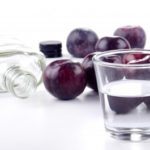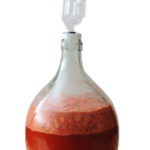Zakwaszanie nastawu – co musisz wiedzieć?
Proces fermentacji tylko pozornie jest procesem prostym. Zawartość pojemnika fermentacyjnego jest z biologicznego punktu widzenia bardzo złożonym ekosystemem i sterowanie przebiegającymi w nim procesami wymagać musi sporo wysiłku. Bardzo dużo uwagi należy poświęcić między innymi zakwaszeniu.
- Podstawa podstaw
pH zacieru może być różne. Zalecana jest jednak wartość w granicach 4,8 do 5,3. Poniżej oraz powyżej tego zakresu fermentacja będzie wprawdzie zachodziła, ale należy pamiętać, że niekoniecznie będzie wówczas procesem dominującym. Co to oznacza w praktyce? Tyle, że drożdże nie będą w stanie przefermentować dodanego cukru albo poza nimi rozwiną się inne organizmy, które przeszkodzą w rozwoju drożdży oraz zepsują smak alkoholu.
- Co się dzieje poza optymalnym przedziałem?
Drożdże, podobnie zresztą jak wszystkie organizmy, w określony sposób reagują na zmiany środowiska. Na poziomie komórkowym objawia się to przestawieniem szlaków metabolicznych w taki sposób, aby przeciwdziałały one zmianom, która je wywołuje. Tyle z naukowego punktu widzenia. W fermentacyjnej rzeczywistości obniżenie pH, czyli wzrost kwasoty roztworu spowoduje zwiększenie wydzielania gliceryny i aldehydów. Jest to zjawisko korzystne, ale tylko wtedy, kiedy przebiega z określoną prędkością i wydajnością. W bardziej zakwaszonym środowisku produkowane są już inne aldehydy, których smak i aromat są ze wszech miar niepożądane.
Niższe pH bezpośrednio oddziałuje na drożdże, hamując nawet niektóre podstawowe procesy biochemiczne, co oznacza śmierć komórek drożdży. Optymalny przedział pH nie szkodzi drożdżom, za to tworzy niekorzystne środowisko do życia dla patogenów, w tym wielu bakterii, które mogłyby zniszczyć nastaw.
Przy wzroście pH obumierają drożdże, rozwija się niepożądana mikroflora, a fermentacja, o ile w ogóle przebiega, powoduje powstawanie wielu produktów ubocznych.
- Jak się to robi w praktyce?
Jest kilka sposobów na obniżenie pH nastawu (wyjściowo będzie ono nieznacznie niższe niż 7). Najpopularniejszym jest dodanie do wody kwasku cytrynowego w ilości mniej więcej 5g na każde 10 litrów nastawu. Zakwaszanie przeprowadza się jednorazowo. Należy też pamiętać, że każdy dodatek owocowy spowoduje obniżenie pH, a to ze względu na zawartość kwasów organicznych w komórkach roślinnych (jabłkowego, cytrynowego i innych).
Na dalszych etapach fermentacji nie trzeba wykonywać żadnych zabiegów – drożdże niejako automatycznie utrzymują pożądane pH, natomiast odpowiednie zaczopowanie kadzi zapobiega przedostawaniu się substancji z zewnątrz. Za utrzymanie kwasowości w czasie fermentacji odpowiedzialny jest kwas węglowy oraz proces autolizy wody, które wystarczająco skutecznie opóźniają wzrost pH, aby do samego końca utrzymało się ono w zakresie tolerancji drożdży.
- Co będzie potrzebne?
Można kupić gotowe substancje zakwaszające na bazie kwasu cytrynowego, ale równie dobrze można posługiwać się zwyczajnym spożywczym kwasem cytrynowym. Należy tylko pamiętać o zaopatrzeniu się w paski lakmusowe albo pH-metr. Dzięki temu uda się właściwie oznaczyć kwasowość roztworu, a przedział tolerancji drożdży jest mimo wszystko niezbyt szeroki, więc należy zrobić to możliwie dokładnie.
Ważna uwaga – etapu zakwaszania nie należy pomijać. W warunkach domowych nie ma możliwości oczyszczenia przefermentowanej cieczy z różnych niepożądanych substancji – w metodach przemysłowych niewielkie różnice smaku powstające w następstwie odchylenia pH od normy i zmiany bioaktywności, można wyeliminować różnymi technikami oczyszczania (np. w trakcie destylacji, rektyfikacji), a w domu o wiele łatwiej takim zanieczyszczeniom zapobiegać.
Znaleziono w Google poprzez frazy:
- zakwaszanie wina








